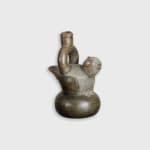

Chavin Culture 1200 BC-400 BC
Chav n-style pottery spread throughout much of the Peruvian highlands and coast in the first millennia B.C.
Characterized by bottles with straight spouts and bowls with straight sides and relatively flat bottoms, Chavin ceramics exhibited extraordinary skill. Colour was seldom used, save for the occasional red and silvery-black paint. Instead, decorative techniques, such as rocker stamping (a technique in which a toothed instrument is impressed into soft clay and then pivoted at one end), burnishing, incision, and modelling were used to create textural contrasts and depth. In the example shown here, a depiction of a bird, a popular motif in Chavin
art, appears in low relief and dominates the body of the bottle. Its smooth and shiny surface stands in striking contrast to the coarse and stippled appearance present on the remainder of the vessel. Ceramics in this style have been found in the galleries and temple plazas at the site of Chavin de Huantar, and are associated with ritual and a veneration of the natural world.
Join our mailing list
* denotes required fields
We will process the personal data you have supplied in accordance with our privacy policy (available on request). You can unsubscribe or change your preferences at any time by clicking the link in our emails.

